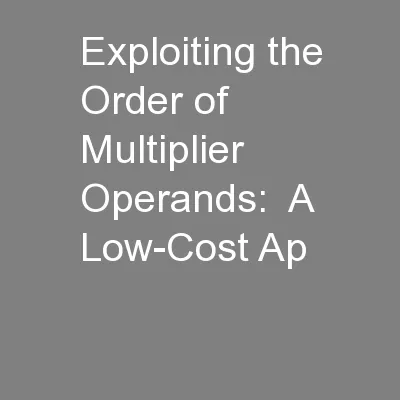

for HCCA Resistance Poulami Das and Debapriya Basu Roy under the supervision of Dr Debdeep Mukhopadhyay Todays talk Introduction ID: 278287
Download Presentation The PPT/PDF document "Exploiting the Order of Multiplier Opera..." is the property of its rightful owner. Permission is granted to download and print the materials on this web site for personal, non-commercial use only, and to display it on your personal computer provided you do not modify the materials and that you retain all copyright notices contained in the materials. By downloading content from our website, you accept the terms of this agreement.
Slide1
Exploiting the Order of Multiplier Operands: A Low-Cost Approach for HCCA Resistance
Poulami Das and Debapriya Basu Roy under the supervision of Dr. Debdeep MukhopadhyaySlide2
Today’s talk Introduction
ECC implementation vulnerabilities – power analysisHCCAOur CountermeasureConclusionSlide3
Private-Key Cryptography
Key is shared by both sender and receiver if the key is disclosed communications are compromised also known as symmetric, both parties are equal hence does not protect sender from receiver forging a message & claiming is sent by sender Slide4
Public-Key Cryptographyprobably most significant advance in the 3000 year history of cryptography uses
two keys – a public key and a private keyasymmetric since parties are not equal uses clever application of number theory concepts to functioncomplements rather than replaces private key cryptographySlide5
Public-Key CryptographySlide6
Public-Key Cryptographydeveloped to address two key issues:
key distribution – how to have secure communications in general without having to trust a KDC with your keydigital signatures – how to verify a message comes intact from the claimed senderpublic invention due to Whitfield Diffie & Martin Hellman at Stanford U. in 1976known earlier in classified communitySlide7
Public-Key CryptographyPublic key schemes utilise problems that are easy (P type) one way but hard (NP type) the other way, e.g.
exponentiation vs logs, multiplication vs factoring. 2 most popular public-key crypto-primitives areRSAECCSlide8
ECC vs RSASlide9
Elliptic Curve scalar multiplicationk.P = (P + P + .. + P)
k times Naïve Double-and-Add AlgorithmSlide10
ECDLP securityTheoretically secure against ECDLP
ECDLP (Elliptic Curve Discrete Logarithm Problem): Suppose E is an elliptic curve over . . Given a multiple Q of P, the elliptic curve discrete logarithm problem is to find given Q = k.PSlide11
VulnerabilitiesSimple power analysis of a naïve Double-and-Add algorithm.
Power trace for key bit 5Slide12
Remedies for preventing SPA[CHES ‘99] SPA-resistant Double-and-Add algorithm
Slide13
Disadvantages cost overhead of dummy operationsp
rone to C-Safe Error Attackvulnerable to DPA (Differential Power Analysis)Slide14
Alternatives Atomic formula-based Algorithmsapplicable to NIST curves
[IEEE TC 2004] Chavelliar-Mames and others, Low-cost solutions for preventing simple side-channel analysis.[IACR eprint 2008] Patrick Longa and others, Accelerating the elliptic curve cryptosystems over prime fields.[CARDIS 2010] Giraud and others,
Atomicity improvement for elliptic curve scalar multiplication.Slide15
More Alternatives …Unified Addition formula inherently secure against SPA – same formula for both addition and doubling operations.
[PKC 2002] Eric Brier and others,Weierstrass elliptic curves and side-channel attacks.[ASIACRYPT 2007] Bernstein and others, Faster addition and doubling on elliptic curves. proposed use of Edward Curves in ECCSlide16
[PKC 2002] Brier-Joye
Addition formula Y2Z = X
3
+ aXZ
2
+ bZ
3
,
(X, Y, Z) E(
F
p
), (
a,b
)
∈
F
p
∈Slide17
[ASIACRYPT 2007] Edward Curve unified formulaSlide18
[SAC 2013] Horizontal Collision Correlation Analysis
Assumptions:Underlying field multiplication uses school-book long integer multiplication algorithmAdversary can detect whether a pair of field multiplications share any common operand(AXB, CXD)
(AX
B
, CX
B
)
(
A
X
B
,
A
X
B
)Slide19
Horizontal Collision Correlation AnalysisWe define:
property 1: when a pair of field multiplications (mi, mj) share one/ two common operands among themselves.property 1a: when a pair of multiplications share exactly one common operand, e.g. – (AB, CB)property 1b:
when a pair of multiplications share exactly
two
common
operands e.g.
– (AB,
AB)
property
2
:
when a pair of field multiplications (m
i
,
m
j
) share
no
common
operand
among
themselves
,
e.g. – (AB, CD)
p
roperty 3:
Given two sets containing field multiplications, only one of the two sets satisfy property 1.Slide20
Horizontal Collision Correlation AnalysisSlide21
Horizontal Collision Correlation AnalysisSlide22
Horizontal Collision Correlation AnalysisHCCA scenario 1:
condition: Only one of addition and doubling should satisfy condition property 3HCCA scenario 2:- can be launched unconditionallySlide23
Our ContributionA zero-cost countermeasure that prevents scenario 1 of HCCA
A randomized countermeasure that requires minimal cost to prevent HCCA scenario 2First practical results on HCCA, and our countermeasure validationSlide24
Asymmetric Leakage of Field MultipliersLong Integer Multiplication AlgorithmSlide25
Asymmetric Leakage of Field MultipliersInformation Leakage model to approximate the correlation between power consumptions of two field multiplications:Slide26
Asymmetric Leakage of Field MultipliersLet us define:
Corr(AB,CB)Corr(AB,BC)Slide27
Asymmetric Leakage of Field MultipliersCorr
(AB,CD)Slide28
Asymmetric Leakage of Field MultipliersObservation 1:
Observation 2:Observation 3: for a multiplication pair with property 1bSlide29
Conversion of ECC algorithm to secure sequence - ExampleSlide30
Conversion for the Brier-Joye formulaSlide31
Secure-sequence conversion Algorithm – Countermeasure 1Create_Graph
();Find_Graphcomponents();Find_Safeseq();Slide32
Countermeasure 2 – algorithm:Slide33
Countermeasure 1 – zero-costCountermeasure 2 – minimal cost HCCA security achieved !!Slide34
Simulation results on HCCA and countermeasure validationResults on Curve1174 (Edward curve) using a 16-bit architecture modelSlide35
Results on SASEBO-GIISlide36
ConclusionCurrently focusing on experimental validationsFuture work –
Can we apply our countermeasure to other ECC algorithms (atomic-formula based algorithms, pairing-based ECC algorithms) ?